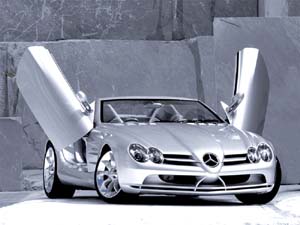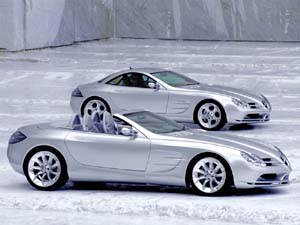|
| |||
 |
Technical Focus: F1 and the Road Car | ||
| by Will Gray, England | |||
|
In a series of articles, Will Gray investigates the input of Formula One on the road car industry, and assesses whether the manufacturers are in it for its marketing or its development potential.
In the late 80's and early 90's, it was Ferrari vs. McLaren in Formula One. At the same time, both brought out road going supercars. Now they're challenging for the championship again, both companies are developing competing road cars. We take a look at the past and the future of the off-track Ferrari-McLaren battles.
Part IV: F1 For the Road - McLaren
Ironically it was the evening after McLaren's defeat at the hands of Ferrari - the team's only loss of the 1988 Formula One World Championship - that the dream of designer Gordon Murray began to develop into reality. He had always wanted to build a sportscar, and now he had the brief to make the best car possible, regardless of cost. McLaren Cars was set up to oversee the project, and the design process began in mid 1990, around the same time that Ferrari's F50 idea was conceived.
The McLaren F1 was to be "The Super Sports Car to end all supercars". Rather than the Ferrari F50's unrefined and brutal F1-for-the-road concept, McLaren wanted their 'F1' to be a fast, usable, and safe driver's car. It would not be directly developed from a Formula One racer, but would use the technologies predominant in the sport.
Rather than beginning to sketch the styling of the car, the team headed for the wind tunnel. In obtaining a well-handling supercar, it was decided that there should be no compromise in aerodynamics. To allow a high top speed, a low drag coefficient target was set, but significant downforce was also required to offer good high speed handling.
Concerned that the Ferrari F50-style race-derived suspension would create an undesirable ride for a refined car such as the F1, Murray took the principal of race design and put it into practice to obtain a well balanced car. Good handling requires the car to have little resistance to movement in turning (it requires a 'low polar moment of inertia'). To achieve this, the components, which must weigh as little as possible, should be positioned close to the centre of gravity. Compromises in this area for road cars usually lead to less efficient handling, but as we have learned already, the word compromise was not in Murray's vocabulary. With careful attention to detail, the desired aim was achieved, and the McLaren was able to ensure a good ride and good handling through the use of race car style double wishbone suspension but with road car style bush mountings. The handling was also improved by reducing the unsprung mass of the car (wheels, tyres, suspension), as this improves the amount of time the contact patch of the tyre and the road are together.
One of the most important achievements of the McLaren F1, and one that was key to McLaren International's requirements, was the development of a new British car company - McLaren Cars. The supercar was to be the tip of the iceberg, but the company has appeared dormant, concentrating on developing the GT versions of the F1 with which they achieved Le Mans success. That is until now. The success of the McLaren Mercedes Grand Prix team has led to a collaboration on a new flagship Mercedes sports car. The fantastic looking Mercedes SLR is McLaren Cars' new baby.
Previous Parts in this Series: Part I: Improving the Breed | Part II: Improving the Brand | Part III: Ferrari
|
| Will Gray | © 2000 Kaizar.Com, Incorporated. |
| Send comments to: gray@atlasf1.com | Terms & Conditions |
 Many Formula One players were involved in the design of the F1, and this ensured that the process was unique. The initial thoughts were on what defined an F1 car for the road, and unlike Ferrari's view, where the engine was used to give the 'F1 feel', the entire concept here was based around offering the driver a single seater experience. This aim was achieved using the car's three person lay-out, which puts the driver in an uncompromised position in the centre of the car. The engine choice was, in fact, initially to be a racing-derived Honda. However, in a step which created the important difference between McLaren and Ferrari's concepts, it was decided not to use an F1-based engine to power the McLaren - so much would have to be changed that they decided it would be cheaper to start from scratch. The Honda connection fell away, and it was eventually down to BMW to supply the powerplant (a company, ironically, the main rival of McLaren's current engine manufacturer Mercedes). With these two decisions made, the next step defined a further difference between standard road car development and that of the McLaren F1.
Many Formula One players were involved in the design of the F1, and this ensured that the process was unique. The initial thoughts were on what defined an F1 car for the road, and unlike Ferrari's view, where the engine was used to give the 'F1 feel', the entire concept here was based around offering the driver a single seater experience. This aim was achieved using the car's three person lay-out, which puts the driver in an uncompromised position in the centre of the car. The engine choice was, in fact, initially to be a racing-derived Honda. However, in a step which created the important difference between McLaren and Ferrari's concepts, it was decided not to use an F1-based engine to power the McLaren - so much would have to be changed that they decided it would be cheaper to start from scratch. The Honda connection fell away, and it was eventually down to BMW to supply the powerplant (a company, ironically, the main rival of McLaren's current engine manufacturer Mercedes). With these two decisions made, the next step defined a further difference between standard road car development and that of the McLaren F1.
 To achieve this, underbody flow was developed using a flat floor with a diffuser, much the same as with the Ferrari F50, and as seen in Formula One. In addition, the design incorporated a throwback to Formula One days gone by. Using a principle similar to that found on the rapidly banned Brabham fan car, the diffuser design was tweaked to work with the cooling airflow. This obtained very efficient downforce, and another F1 concept had been employed.
To achieve this, underbody flow was developed using a flat floor with a diffuser, much the same as with the Ferrari F50, and as seen in Formula One. In addition, the design incorporated a throwback to Formula One days gone by. Using a principle similar to that found on the rapidly banned Brabham fan car, the diffuser design was tweaked to work with the cooling airflow. This obtained very efficient downforce, and another F1 concept had been employed.
 Despite their differences, the one most common thing between McLaren and Ferrari's supercars is their overall construction. Both use the Formula One technology of a carbon fibre monocoque, and both are still the only cars to have done so - probably because this is one of the major ingredients creating their lottery-level price tags. Cost aside, the solution is an ideal one, as it provides the required strength with low weight. Such strength, in fact, that the McLaren F1 became the only car ever to be able to drive away from a crash test at the Motor Industry Research Association. Before this, however, McLaren had proven the monocoque's safety in an improvised test of their own, when the original prototype, the XP1, dramatically crashed in the deserts of Namibia. Despite numerous rolls followed by the car being engulfed in flames, the test driver walked away unharmed.
Despite their differences, the one most common thing between McLaren and Ferrari's supercars is their overall construction. Both use the Formula One technology of a carbon fibre monocoque, and both are still the only cars to have done so - probably because this is one of the major ingredients creating their lottery-level price tags. Cost aside, the solution is an ideal one, as it provides the required strength with low weight. Such strength, in fact, that the McLaren F1 became the only car ever to be able to drive away from a crash test at the Motor Industry Research Association. Before this, however, McLaren had proven the monocoque's safety in an improvised test of their own, when the original prototype, the XP1, dramatically crashed in the deserts of Namibia. Despite numerous rolls followed by the car being engulfed in flames, the test driver walked away unharmed.
 Through Formula One, Mercedes has left behind its luxurious but sedate image, and made way for a sportier form. Although nowhere near an F1 for the road, McLaren's new project at least takes styling cues from the F1 car, and when viewed front-on, the morphed shape of Mika Hakkinen's F1 Machine is clear to see. The new road car's body will use aluminium and composite fibres to save weight, and it has a semi-automatic gearbox - although it is not of the paddle shift type available on the Ferrari 360. It is expected to reach 200mph when it enters production in 2003, and at that it will be more than a match for the beast of Maranello. This then, is McLaren's challenge to Ferrari on the road - it's just a shame we'll have to wait so long to find the winner
Through Formula One, Mercedes has left behind its luxurious but sedate image, and made way for a sportier form. Although nowhere near an F1 for the road, McLaren's new project at least takes styling cues from the F1 car, and when viewed front-on, the morphed shape of Mika Hakkinen's F1 Machine is clear to see. The new road car's body will use aluminium and composite fibres to save weight, and it has a semi-automatic gearbox - although it is not of the paddle shift type available on the Ferrari 360. It is expected to reach 200mph when it enters production in 2003, and at that it will be more than a match for the beast of Maranello. This then, is McLaren's challenge to Ferrari on the road - it's just a shame we'll have to wait so long to find the winner